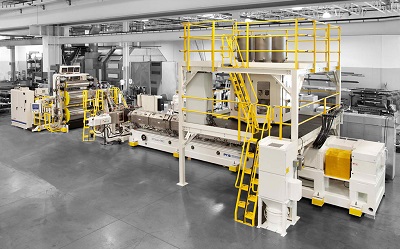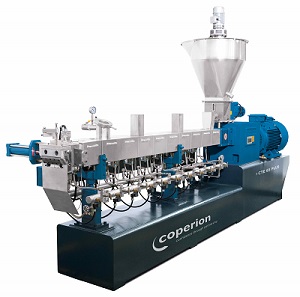Twin screw extruders are used for mixing, compounding or reacting plastic raw materials. The design of these new breed of extruders gives enough flexibility to meet the formulation required. Compared with single screw extruders, twin-screw extruders offer a host of processing advantages in terms of mixing capability, processibility, and overall end-product quality. It is no surprise that a growing number of processors opt to turn to twin-screw extrusion systems for their processing needs. In response, manufacturers of these equipment are exerting efforts to design equipment that meet the needs of today’s plastics processors.
Dryer-less system to convert mixed regrind
Processing Technologies International (PTi), a global manufacturer of high-performance sheet extrusion machinery, has launched its unique “dryer-less” twin-screw sheet extrusion production system to the market. The system can convert mixed regrind (PETG and APET) into processable, high-quality thermoformed sheet for consumer packaging.
“Our dryer-less twin-screw system is a new option that is well suited to process post-consumer and post-industrial PET GAG regrind, unlike conventional extrusion systems that require a dryer and a crystallizer,” said Sushant Jain, senior scientist for PTi. Production-scale trials were run on PTi’s 85-mm high-vacuum twin-screw extruder with 100% GAG scrap. Clear mixed material sheet was produced thus demonstrating a successful method to recycle GAG sheet scrap. The final blend was composed of approximately 20% PETG/80% APET.
Many thermoformers use a PET-GAG sheet which is a PETG/APET/PETG multilayer sheet structure for consumer packaging. The benefit of this structure is that the PETG layers offer superior heat sealing and printing properties over APET. However, the scrap from this sheet structure ends up in a landfill because extruders can’t effectively process this material with conventional equipment.
Recycling the trim and thermoforming skeleton scrap is a challenge due to the widely different drying temperatures for PETG and APET, according to Mr. Jain. PETG’s drying temperature is 150°F (66°C) while APET’s is approximately 300°F (149°C). At higher temperatures, pellets/flake can agglomerate and plug up the crystallizer and dryer. The HVTSE® dryerless extrusion system is ideally suited to process mixed PETG and APET sheet scrap. PTi’s patented High-Vacuum Twin-Screw Extruder (HVTSE®)* technology, which allows PET to be processed without the need for crystallizing and drying, can easily convert this material into usable sheet.

PTi’s patented High-Vacuum Twin-Screw Extruder
HVTSE® systems ranging from 85 to 170mm are capable of processing PET at rates ranging from 2,300 lb per hour (1,045 kg/hr) to 5,500 lb/hr (2,500 kg/hr), and convert a variety of resins including post-consumer and industrial PET/PLA, PP, HDPE, HIPS and more. The energy-efficient design allows virgin or recycled PET to be processed without the need for raw material drying and crystallizing. It employs a single atmospheric and dual high-vacuum, vent system with a co-rotating twin-screw extruder. This novel approach allows moisture and other volatiles to be removed as part of the extrusion process. The dryerless sheet extrusion system is an eco-conscious manufacturing solution which delivers major energy and cost savings, according to Matt Banach, PTi’s senior vice president of sales and marketing. It is a significant reduction in the carbon footprint of virgin and recycled PET sheet production.
In terms of sustainability advantages, the HVTSE® process provides a reduction of about 80-85 kWh/1000 lbs in energy consumption versus conventional PET processing. This savings equates to more than 31.6 gigawatt hours of annual power consumption when factored across PTi’s 470 million pounds of theoretical installed HVTSE® PET capacity base. The resultant energy savings could mean a reduction in CO2 gas emissions of more than 23 million pounds per year from fossil-fuel burning power plants, the company estimates.
The results of the successful demonstration project are being transferred to PTi customers. The company is also focused on the development of other new technology that converts mixed materials of dramatically different (incompatible) densities, melt temperatures and melt indexes, etc. into durable goods.
Enhanced cost/performance ratio
Coperion Nanjing, China offers CTE 50 PLUS twin screw extruder series. The CTE PLUS is produced at the China facility of Coperion and equipped with a new gearbox engineered by Coperion Stuttgart, Germany. IT offers a new terminal box that meets high safety standards and is supplied on a unitized base frame. The series offers an attractive cost/performance ratio and its precise manufacturing ensures the economical processing of a wide range of applications at high product quality. Before delivery each CTE PLUS extrusion system is subjected to a Factory Acceptance Test (FAT) at the Coperion Nanjing site to ensure high quality standards. As an option, the CTE PLUS series can be provided with CE certification.
To improve reliability and to ensure longer life time Coperion Stuttgart, Germany, has engineered new gearboxes for the CTE PLUS that can bear a specific torque of 7.2 Nm/cm³ and are exchangeable with old generation CTE’s gearboxes. The rotating parts and bearings of the new gearboxes have been redesigned, tooth width has been enlarged and tooth flank and profile have been optimized to ensure a perfect intermeshing surface. The gearboxes offer improved cooling and oil supply and the geometry of their housing has been optimized for higher stiffness and prevention of vibrations. The gearbox housings are all manufactured in-house at Coperion Nanjing. After production all gearbox housings are checked in-house with a 3D inspection machine to ensure dimensional precision up to 1.4 μm. Every single CTE PLUS gearbox is subjected to almost 40 inspection items.

CTE PLUS from Coperion Nanjing
Coperion Nanjing - the production site of the CTE series - has implemented comprehensive standards to improve production quality. Coperion Nanjing is using numerous modern, German supplied machining centers and quality check instruments. The state-of-the-art CNC machining centers for the production of barrels and screw elements as well as the inspection centers for barrels, screw elements and gearbox housings ensure high production quality.
Cost-effective compounding
KraussMaffei Berstorff released to the Asian market its ZE 52 Basic twin-screw extruder designed for high-performance and cost-effective compounding. In particular, the machine was installed at Suzhou Sunway Polymer Co. Ltd. last year. The Suzhou-based company opted for ZE Basic twin-screw extruders to enhance both productivity and flexibility. In 2014, Suzhou Sunway installed a ZE 52 Basic equipped with a side feeder. This means that the company currently operates a ZE 25 UTXi laboratory extruder and three ZE 52 Basic twin-screw extruders at its production facilities.
The ZE 52 Basic is equipped with a water-cooled drive unit for a maximum speed of 600 rpm and with a side feeder for the introduction of fillers. To ensure adequate and efficient wear protection for this type of process, housings made either of nitriding steel or induction hardened CrMo with an l/d ratio of 4, 8, 10, or 12 can be used. The C-clamp flange system substantially reduces housing assembly and disassembly times. Depending on the application, the KraussMaffei Berstorff ZE Basic series can be provided with different screw elements of complementary functionality that are tailored to specific requirements in compounding.
Special applications supported
Bandera’s product range includes cutting-edge co-rotating twin-screw extruders (2C series) in standard configuration and/or for special applications (HVTSE series). The direct compounding/recycling extrusion eliminates the need for pelletizing, thus leading to a one-step transforming process. Hence, the resulting benefits are definitely important in terms of power saving, minimized investments and simplified production.
The “Compounding/Recycling” method ensures cost effective process with minimized power costs, up to half the standard systems. Cost reduction is achieved since there is no longer any need for material/compound re-processing, reduction of shear and thermal stress normally associated with processes requiring a new melting/cooling stage and lower energy costs due to the removal of compound re-heating and cooling. The method also presents no limitation in extruder feeding as up to 100% ground flakes can be processed without any reduction in line output.














